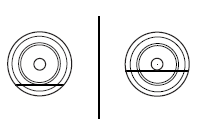Driving through water

If driving through deep or standing water is unavoidable, proceed very slowly. Never drive through water that is higher than the bottom of the wheel rims (for cars) or the bottom of the hubs (for trucks).

When driving through water, traction or brake capability may be limited.
Also, water may enter your engine’s air intake and severely damage your engine or your vehicle may stall. Driving through deep water where the transmission vent tube is submerged may allow water into the transmission and cause internal transmission damage. Once through the water, always dry the brakes by moving your vehicle slowly while applying light pressure on the brake pedal. Wet brakes do not stop the vehicle as quickly as dry brakes.
See also:
Child safety locks
When these locks are set, the rear
doors cannot be opened from the
inside.
The rear doors can be opened from
the outside when the childproof
door locks are set, but the doors are
unlock ...
Setting the gap distance
The distance between your vehicle
and the vehicle in front of you can
be decreased or increased by
pressing <---> control. GAP <--->
will be displayed in the message
center. Thre ...
BLIS -CTA fault operation
If the BLIS -CTA senses a fault on either the left or right sensor, the
BLIS alert indicator will go ON and remain ON and the message center
will display BLIND SPOT SYSTEM FAULT or CROSS TRAFFIC S ...
